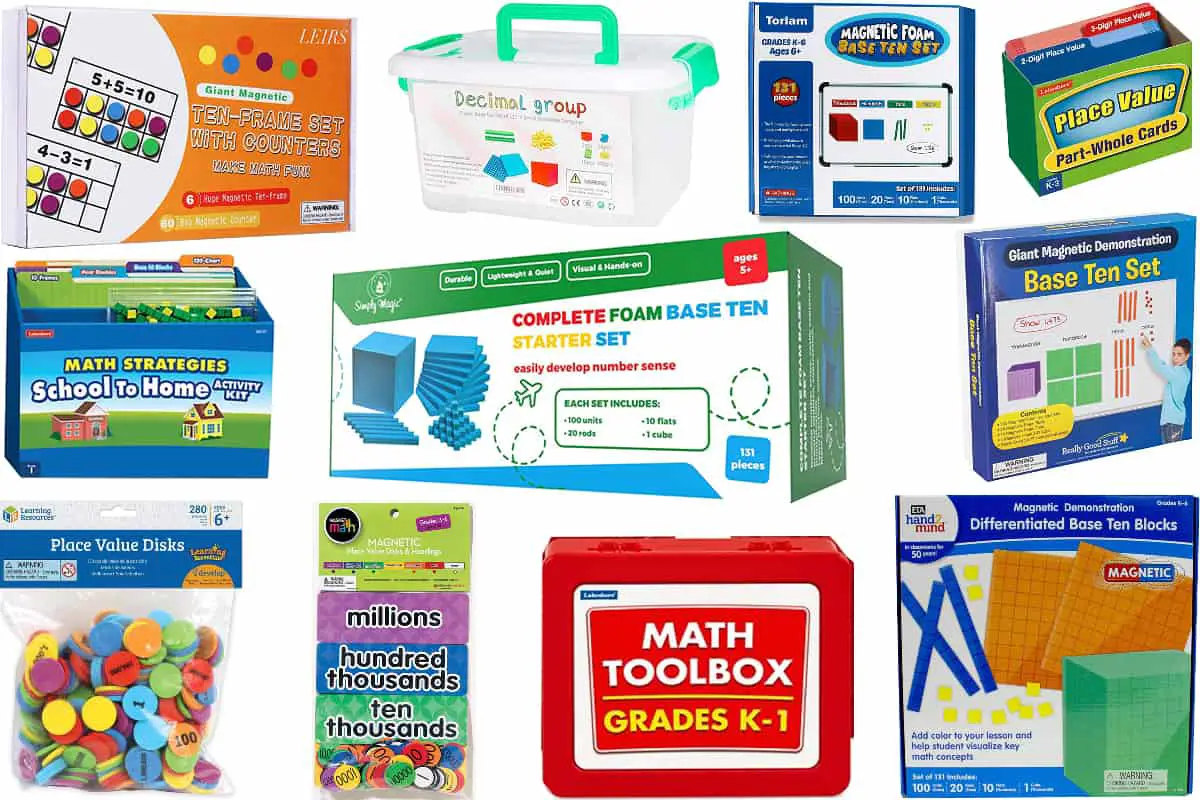This post contains affiliate links.
Manipulatives help children achieve a concrete understanding of place value concepts. And there are various types available: cubes, blocks, ten frames, disks, chips, charts, and activity sets that I list here.
Place Value Manipulative Activities Comparison Table
The place value activities in this list are good for children from kindergarten to grade 3 level.
| Game | Type | Age | Players | For | Price | Rating |
|---|---|---|---|---|---|---|
| Base 10 Blocks (MB One) | 3D Plastic Blocks | 6-8 | 1-4 | Home, School | $$ | ★★★★☆ |
| Base Ten Blocks (Neorod) | 3D Plastic Blocks | 6-8 | 1-4 | Home, School | $$$ | ★★★★☆ |
| Interlocking Base Ten Blocks | 3D Plastic Blocks | 6-8 | 1-4 | Home, School | $$$ | ★★★★☆ |
| Magnetic Foam Base Ten Set | Flat Blocks for whiteboard | 6-8 | teacher | School | $$$ | ★★★★☆ |
| Giant Magnetic Base Ten Set | Flat Blocks for whiteboard | 6-8 | teacher | School | $$$$ | ★★★☆☆ |
| Base Ten Blocks (Hand2mind) | Flat Blocks for whiteboard | 6‑8 | teacher | School | $$$ | ★★★☆☆ |
| Complete Foam Base Ten Set | Foam Blocks | 6-8 | 1-4 | School | $$$ | ★★★☆☆ |
| Base Ten Value Frame | Ten-Frame for blocks | 5-7 | 1-2 | School | $$ | ★★★★★ |
| Magnetic Ten Frames | Ten-Frame | 6-8 | 2-4 | School | $$$ | ★★★★☆ |
| Ten Frame Set with Counters | Ten-Frame | 6-8 | 2-6 | School | $$ | ★★★☆☆ |
| Place Value Chips | Disks | 6-10 | 2-4 | School | $$ | ★★★★☆ |
| Place Value Disks | Disks | 6-10 | 2-4 | School | $$ | ★★★☆☆ |
| Magnetic Place Value Disks and Headings | Disks | 6-10 | 2-4 | School | $$ | ★★★☆☆ |
| Counting Straws Pocket Chart | Straw Chart | 6-8 | 2-4 | School | $$ | ★★★☆☆ |
| Counting Caddie and Place Value Pocket | Straw Chart | 6-8 | 2-4 | School | $$ | ★★★★★ |
| Place Value Activity Kit | Activity Set | 6-8 | 1-2 | Home, School | $$$ | ★★★★☆ |
| Building Bricks Place Value Problem Solving Kit | Activity Set | 7-8 | 1-4 | School | $$ | ★★★★★ |
| Place Value Activity Station | Activity Set | 7-9 | 1-4 | School | $$$$ | ★★★★☆ |
| Whole Number Place Value Cards | Activity Set | 7-9 | 2-4 | School | $$$ | ★★★☆☆ |
| Visualize it! Part-Whole Place Value Cards | Activity Set | 6-8 | 2-4 | School | $$$ | ★★★☆☆ |
| Hands-on Math Teaching Kits | Activity Set | 6‑10 | 2-4 | School | $$$$$ | ★★★☆☆ |
| Math Manipulative Toolbox | Activity Set | 5-6 | 2-4 | School | $$$$$ | ★★★☆☆ |
| Math Strategies School-To-Home Activity Kit | Activity Set | 7-8 | 2-4 | School | $$$ | ★★★★☆ |
| Hands-on Math Manipulative Bundle | Activity Set | 5-8 | 2-4 | School | $$$$$ | ★★★☆☆ |
Block-Based Place Value Activities
Base ten blocks offer an invaluable visual representation of place value for whole numbers up to thousands (10x10x10 cubes). They are probably the N°1 tool that a teacher will want to have in their classroom to make students experience directly the base 10 system.
Most base 10 blocks have a different block color for ones, tens, hundreds, and thousands (often respectively yellow, green, blue, and red). This is in my opinion preferable to having a system with one color only.
There are also “real blocks” (3-dimensional blocks) and “flat magnetic blocks” (which give the optical illusion that they are real blocks):
- “Real” 3D blocks are good for direct practice by children. Of course the size of the blocks is small because they are sized according to children’s hand size
- Flat magnetic blocks are oversized in order for teachers to use them on the board (children can see them at a distance.
So none of these two systems are inherently better or worse, they just serve different purposes.
3-dimensional Plastic Base 10 Blocks
The following 3 products all comprise:
- 100 yellow units (represent ones)
- 10 green rods (represent tens)
- 10 blue flats (represent hundreds)
- A red cube (represent thousands)
The blocks are made of ABS plastic.
They are essentially similar and I give 4 stars to all of them.
I recommend them for 6–8-year-old children at home or school because they can practice building numbers and get a visual representation of quantities up to a thousand.
Base 10 Blocks (MB One)
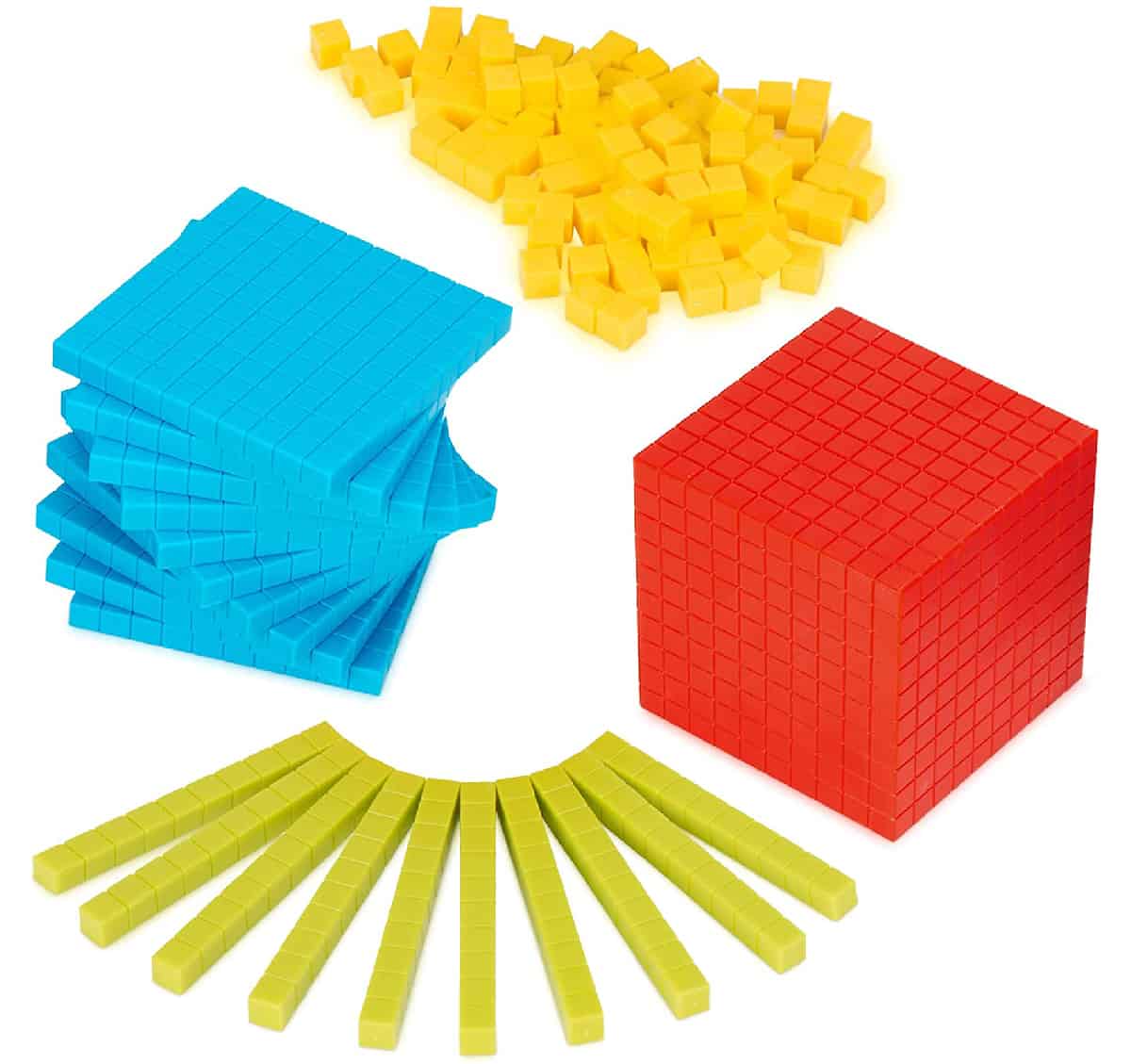
★★★★☆
For Home and School | Age: 6-8 | 1-4 Students
Base 10 Blocks consist of 121 pieces of manipulatives that can be used to build numbers and learn place values up to 4 digits.
consist of 121 pieces of manipulatives that can be used to build numbers and learn place values up to 4 digits.
Base Ten Blocks (Neorod)
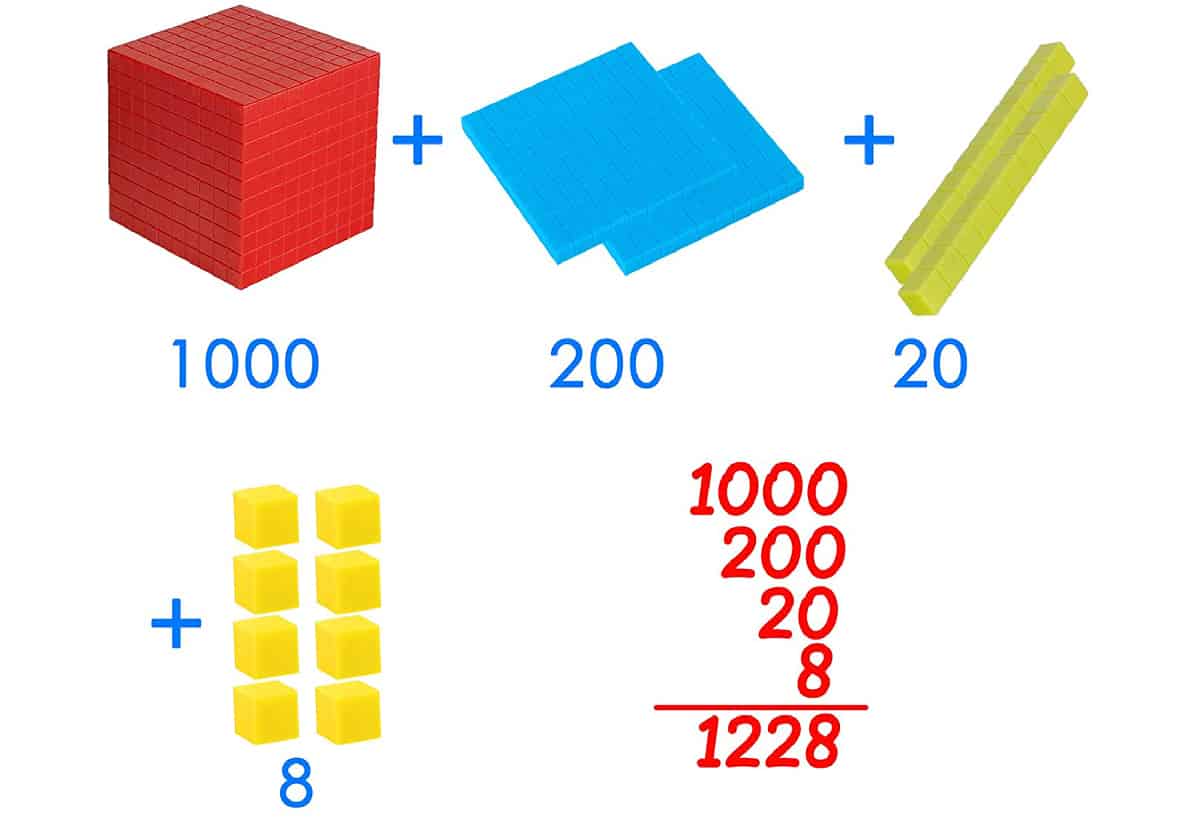
★★★☆☆
For Home and School | Age: 6-8 | 1-4 Students
Base Ten Blocks from Neorod is almost identical to MB One’s.
from Neorod is almost identical to MB One’s.
Interlocking Base Ten Blocks (Didax)

★★★★☆
For School | Age: 6-8 | 1-4 Students
Interlocking Base Ten Blocks from Didax is similar to the previous two.
from Didax is similar to the previous two.
Foam 3D Blocks
Complete Foam Base Ten Set (The Technie Unit Trust)
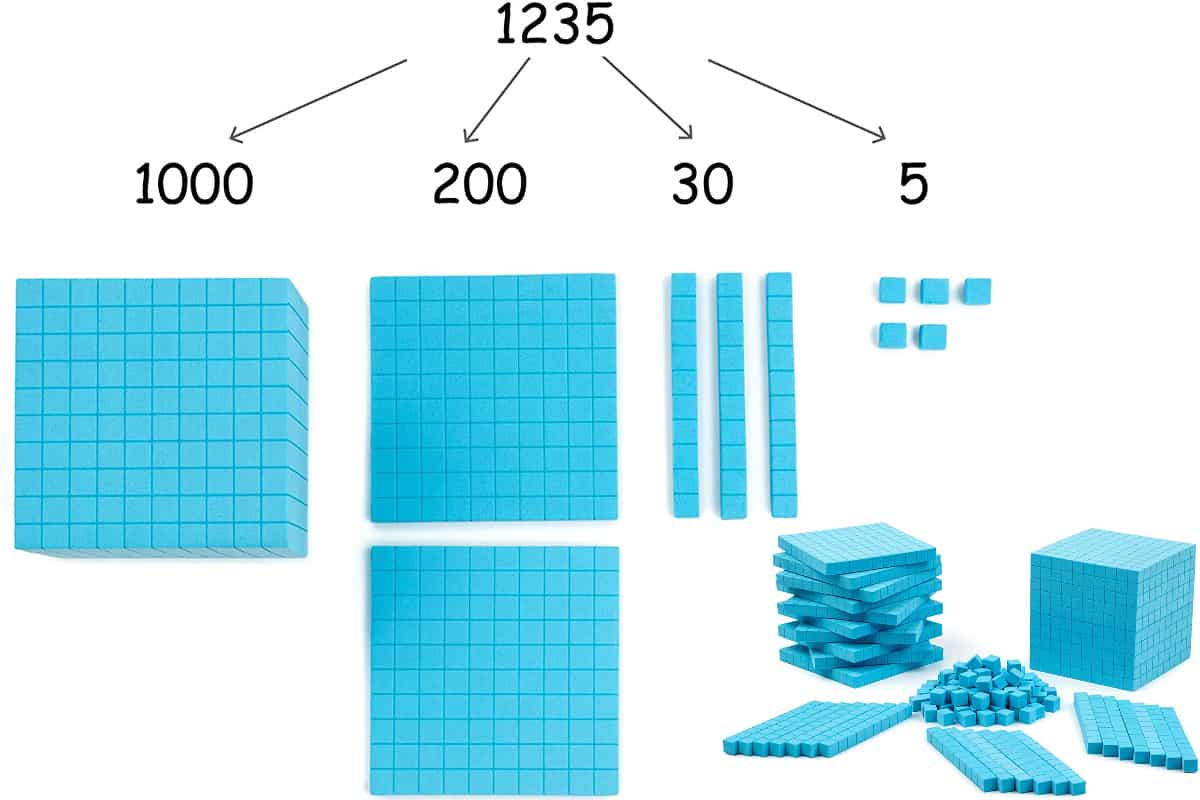
★★★☆☆
For School | Age: 6-8 | 1-4 Students
Complete Foam Base Ten Set contains 131 pieces of lightweight foam blocks that can be used to study place values up to thousands.
contains 131 pieces of lightweight foam blocks that can be used to study place values up to thousands.
In this set, children will work with
- 1 cube (thousand)
- 10 flats (hundreds)
- 20 rods (tens)
- 100 units (ones)
Flat Magnetic Base 10 Blocks To Use on Whiteboards
The following three products are similar. they enable teachers to show base 10 blocks up to a thousand on their whiteboard.
I prefer Torlam’s product because it uses the same colors as plastic 3D base 10 blocks that students use (yellow for ones, green for tens, blue for hundreds, red for thousands). But the fact the product from Really Good Stuff does not use Yellow is also justified by the fact Yellow is difficult to see from afar on a whiteboard.
Magnetic Foam Base Ten Set (Torlam)
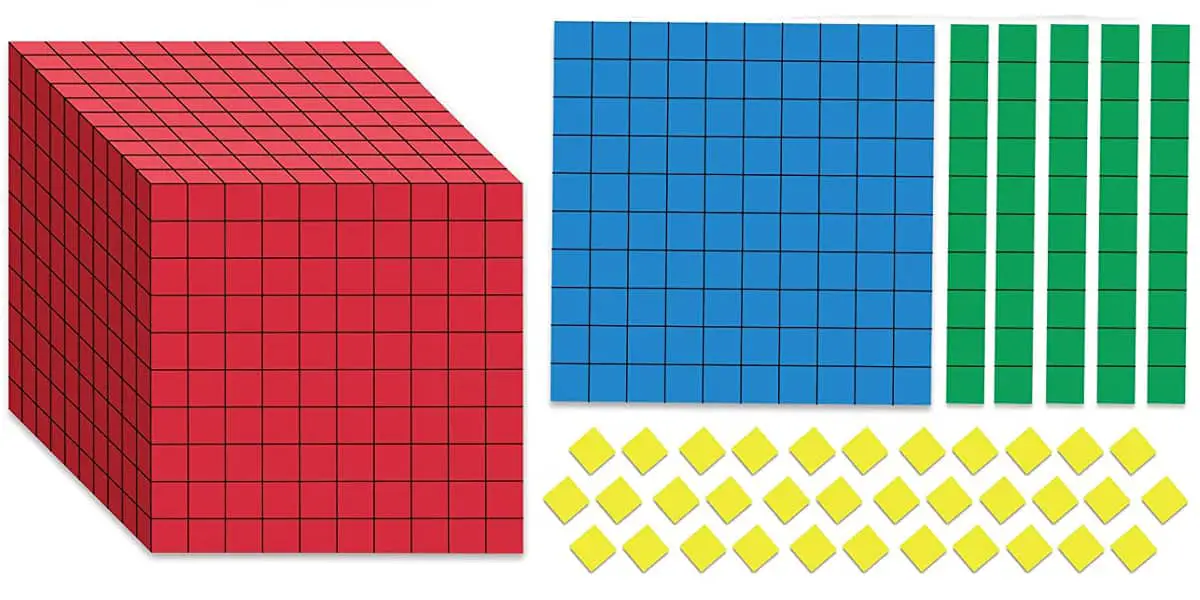
★★★★☆
For School | 6-8 | teacher
Magnetic Foam Base Ten Set enables 6–8-year-old children to learn place values with 4 digits by constructing the quantities on the whiteboard using color-coded magnetic blocks.
enables 6–8-year-old children to learn place values with 4 digits by constructing the quantities on the whiteboard using color-coded magnetic blocks.
The set consists of:
- A red cube (thousands)
- 10 blue flats (hundreds)
- 20 green rods (tens)
- 100 yellow units (ones)
Base Ten Blocks (Hand2Mind)
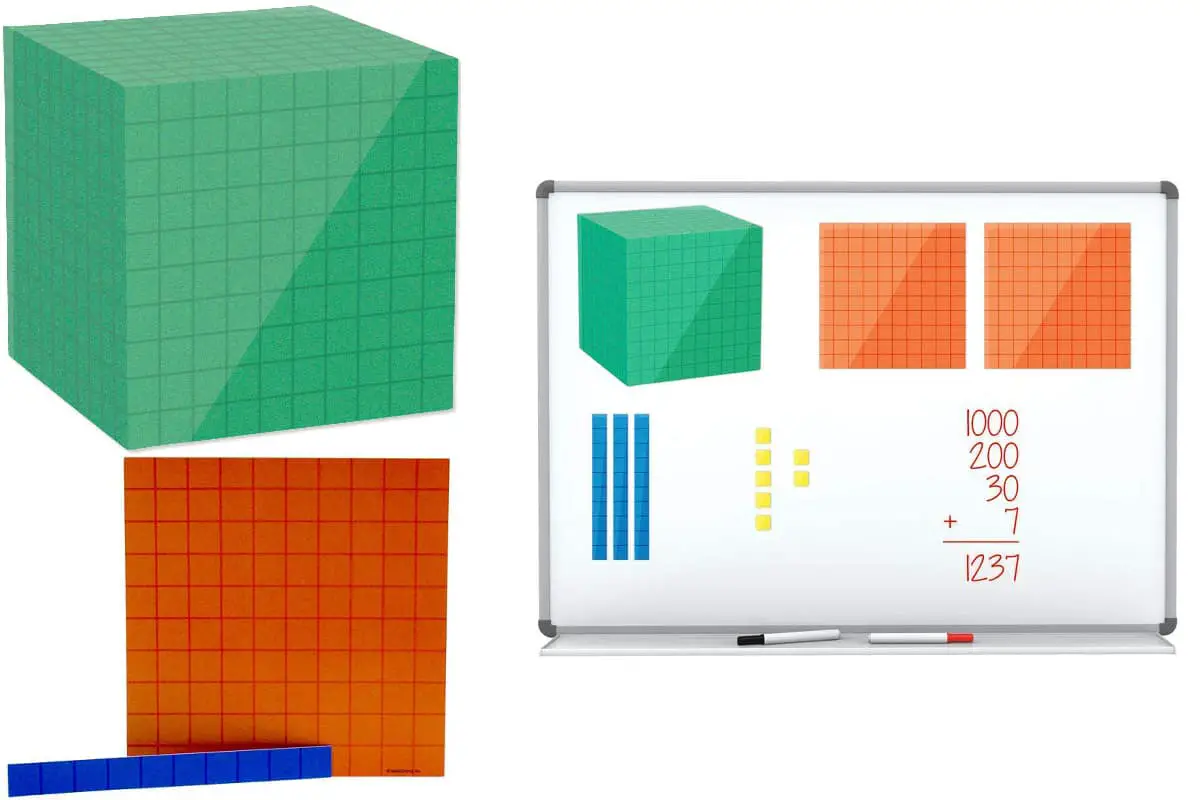
★★★☆☆
For School | Age: 6-8 | Teacher
Hand2Mind’s Base Ten Blocks , unlike the previous set, has a different color scheme:
, unlike the previous set, has a different color scheme:
- 100 yellow blocks for ones
- 20 Blue rods for tens
- 10 Orange flats for hundreds
- 1 Green cube for thousands
It has an activity guide for addition, subtraction, and other math concepts.
Giant Magnetic Base Ten Set (Really Good Stuff)
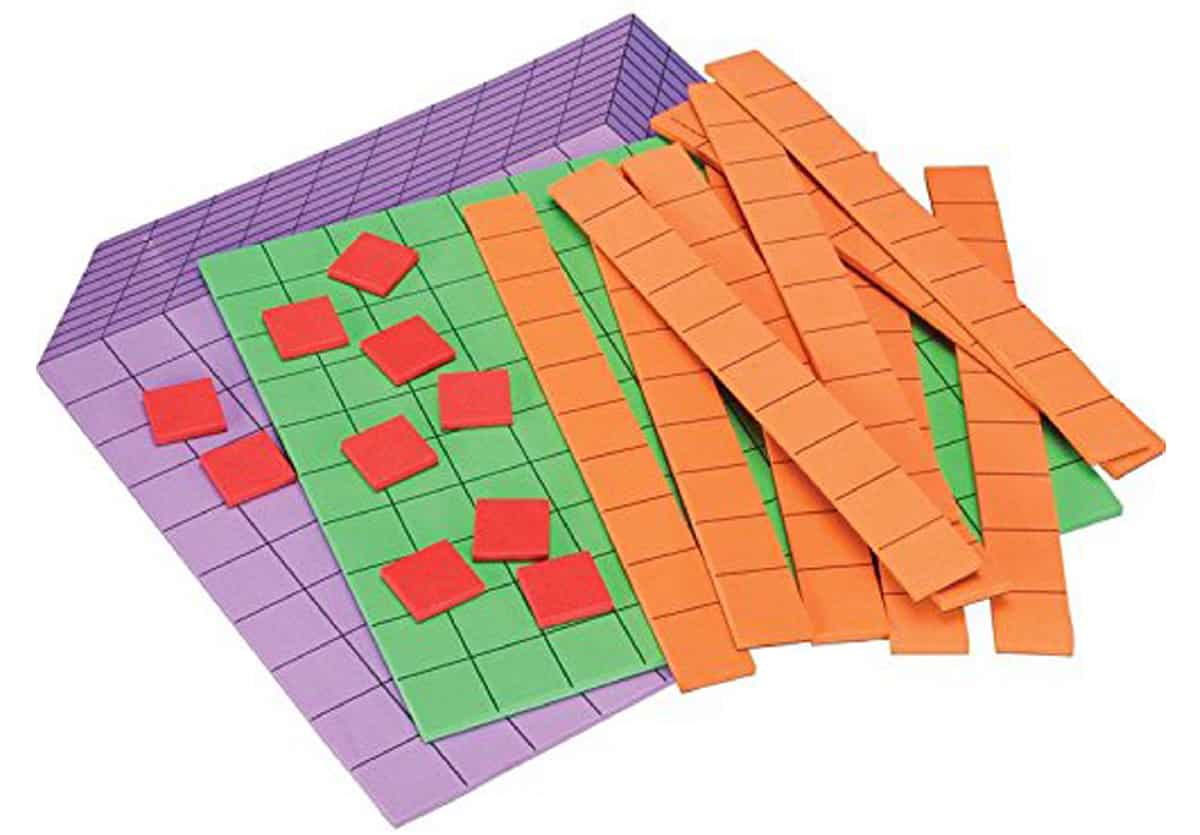
★★★★☆
For School | Age 6-8 | teacher
Giant Magnetic Base Ten Set includes 131 pieces of magnetic base foam “flat blocks” (the base square cubes measure 1” by 1” each).
includes 131 pieces of magnetic base foam “flat blocks” (the base square cubes measure 1” by 1” each).
Having red “ones” is justified because they are visible from afar on a whiteboard.
Base 10 Frame for Blocks
Base Ten Value Frame (Didax)

★★★★★
For School | Age 5-7 | 1-2 Students
Most base ten blocks are played without a frame. With Base Ten Value Frame from Didax, children can arrange separately bought 1 cm base 10 blocks in foam frames.
from Didax, children can arrange separately bought 1 cm base 10 blocks in foam frames.
This set includes 21 number tiles and a foam frame that is partitioned into hundreds, tens and ones.
It is great for Kindergarten and first grade as it helps visualize place values up to 3 digits, and write the corresponding digits, which is not the case with standard blocks.
Ten Frames- Based Place Value Activities
Magnetic Ten Frames (Simply Magic)
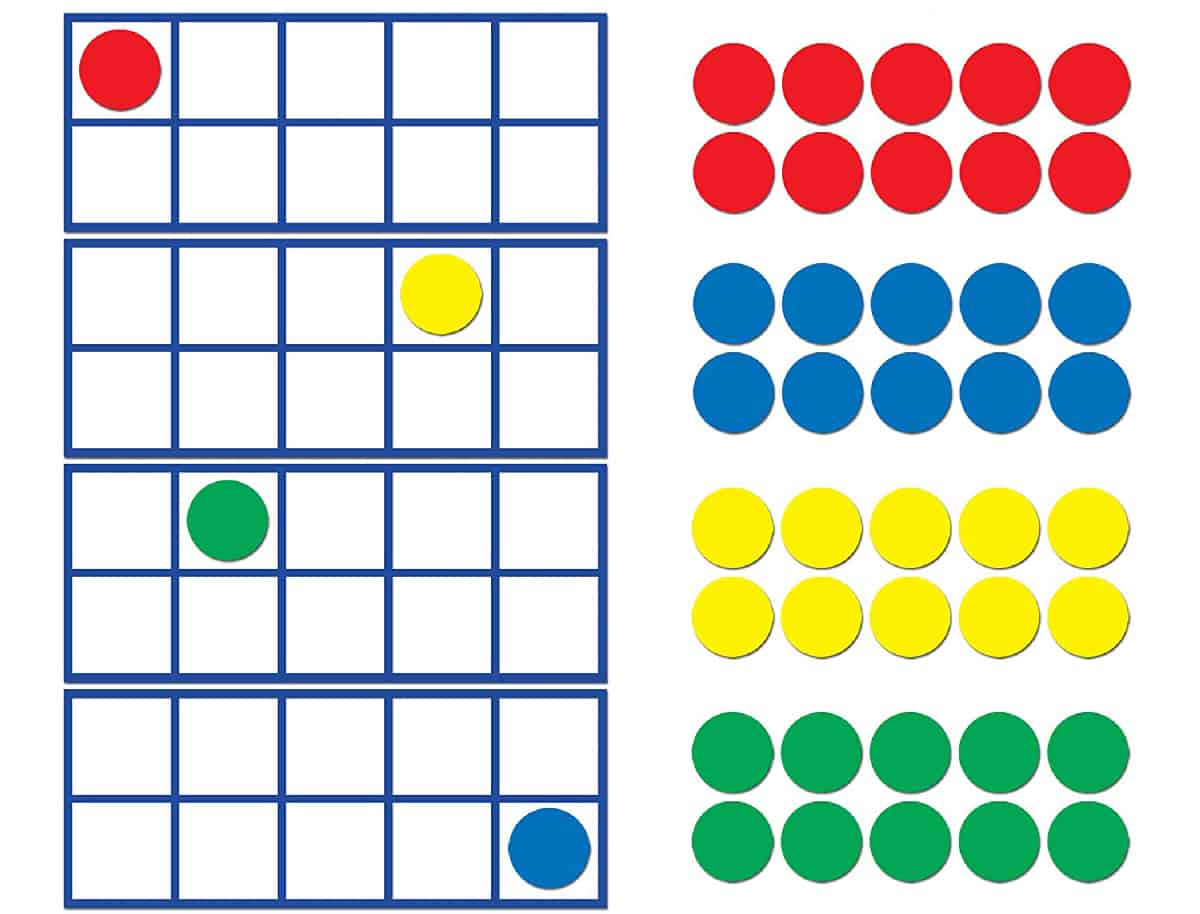
★★★☆☆
For School | Age 5-7 | 2-4 Students
Simply Magic’s Magnetic Ten Frames are helpful for teachers to show place value, small additions, and subtractions on the whiteboard. It contains 4 large erasable magnetic frames and 40 magnetic counter chips in 4 colors (green, red, yellow, and blue).
are helpful for teachers to show place value, small additions, and subtractions on the whiteboard. It contains 4 large erasable magnetic frames and 40 magnetic counter chips in 4 colors (green, red, yellow, and blue).
Ten Frame Set with Counters (Leirs)
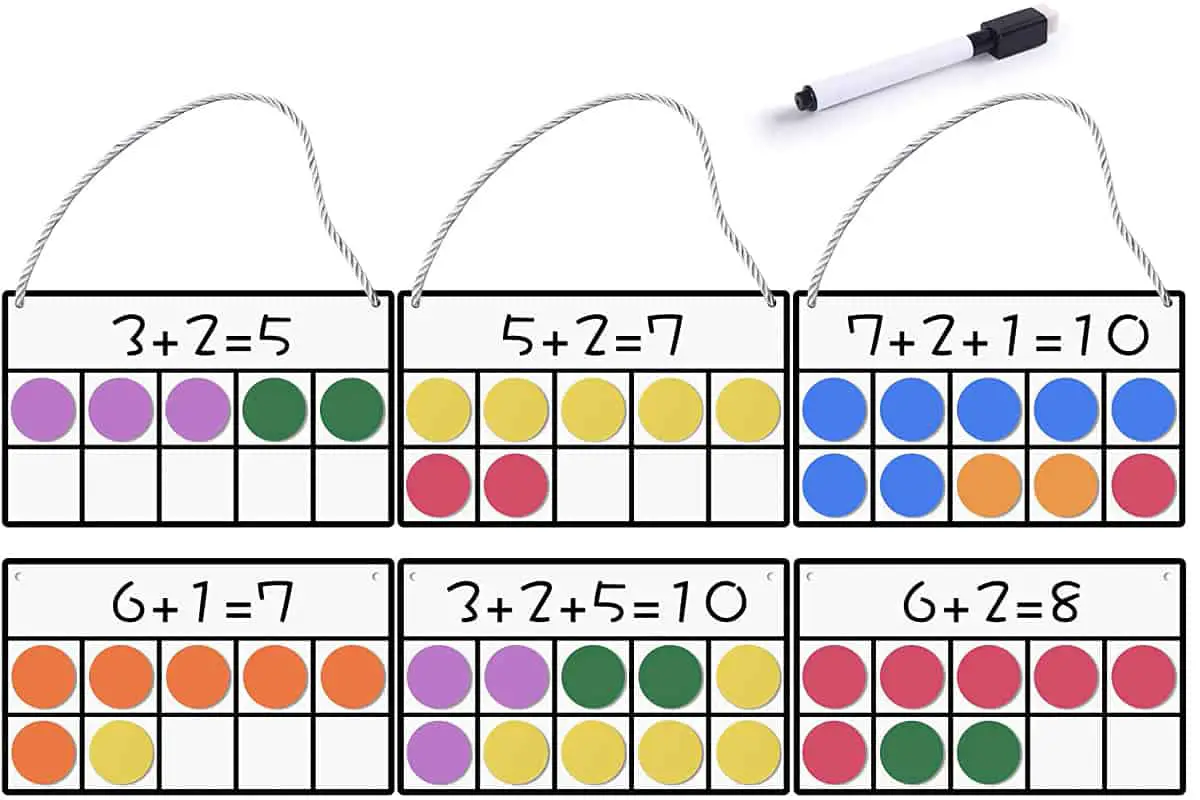
★★★☆☆
For School | Age 5-7 | 2-6 Students
Leir’s Ten Frame Set with Counters is similar but contains 6 magnetic frames and 60 magnetic chips in 6 colors.
is similar but contains 6 magnetic frames and 60 magnetic chips in 6 colors.
Both products are usable by children as well but their large size makes them more practical for the whiteboard.
Place Value Chips/Disks
Place value chips are a bit like coins, which appeals to children. I prefer Learning Resource’s chips set to Hand2Mind’s one as the numbers are printed in a larger font and much more readable. Dowling Magnets’ chips are interesting too as they are magnetic and thus can be used by a teacher on a whiteboard.
Place Value Chips (Learning Resources)

★★★★☆
For School | Age 6-10 | 2-4 Students
In Place Value Chips , players choose from 40 multicolored chips for each place value (a total of 280 pieces) from ones to millions.
, players choose from 40 multicolored chips for each place value (a total of 280 pieces) from ones to millions.
Young children can start with sorting numbers and counting them while grade-schoolers can explore place value concepts, addition and subtraction. Compared to Place Value Discs from Hand2mind, this set focuses on whole number representation only.
Children will enjoy using these chips because they are colorful, clearly labeled, easy to use and durable (made of thicker quality of foam).
Place Value Discs (Hand2Mind)
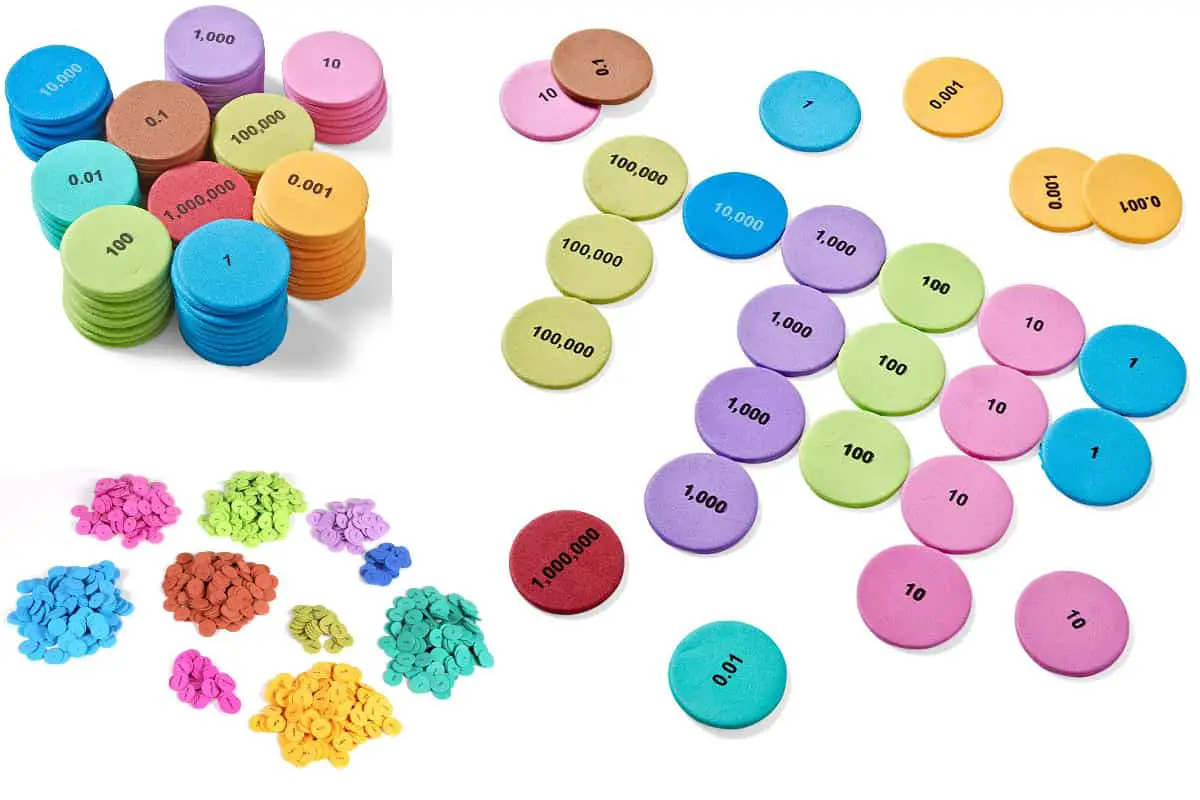
★★★☆☆
For School | Age 6-10 | 2-4 Students
Place Value Discs is an excellent learning tool for studying decimals and place values with 7 digits.
is an excellent learning tool for studying decimals and place values with 7 digits.
It consists of 200 multicolored foam chips that represent whole numbers and decimals. They can compare place values by laying the pieces together or taking the pieces away.
I recommend these chips to 6–10-year-old children because they can be used with other place value manipulatives like base ten blocks, counters for ten frames and visual aid for addition and subtraction.
Magnetic Place Value Disks and Headings (Dowling Magnets)
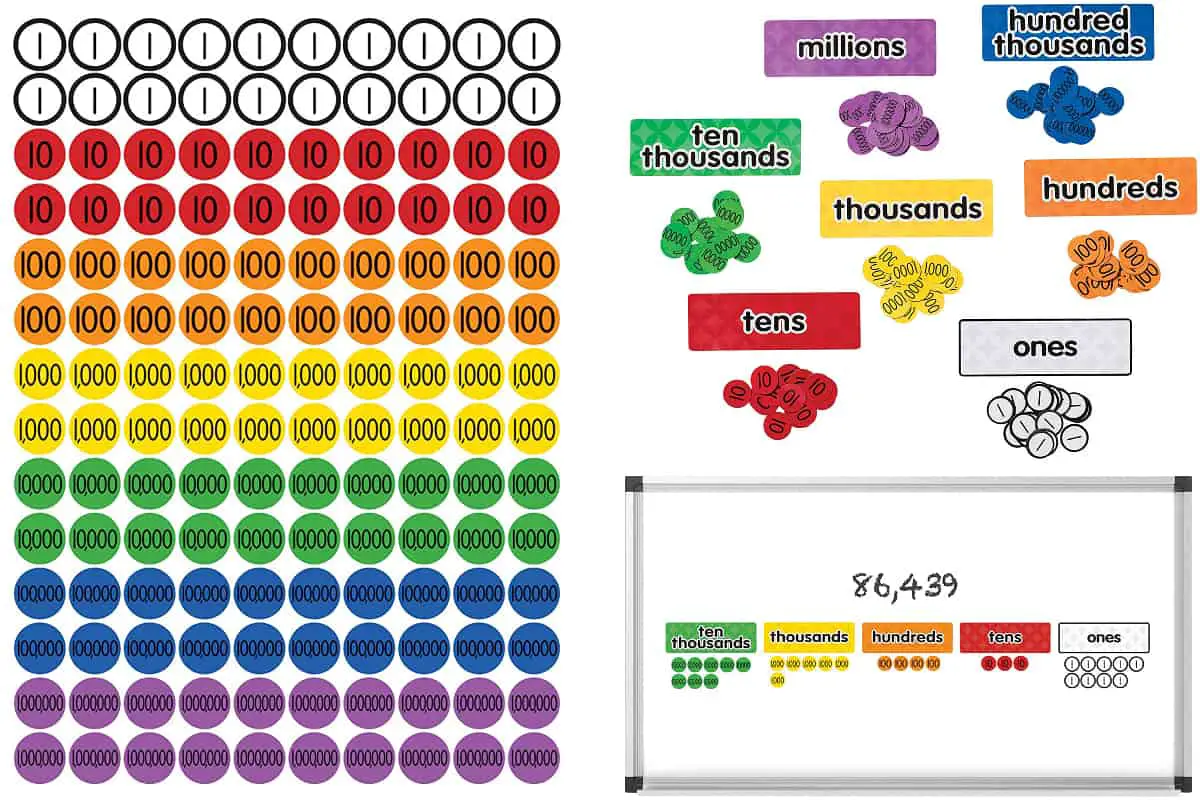
★★★☆☆
For School | Age 6-10 | teacher
Magnetic Place Value Disks and Headings is good for place value work from Grade 1 to Grade 6, from “ones” to “millions” using 140 multicolored magnetic chips (there are 20 chips for each place value).
is good for place value work from Grade 1 to Grade 6, from “ones” to “millions” using 140 multicolored magnetic chips (there are 20 chips for each place value).
The chips are similar to a quarter in size, and can be used to demonstrate place values on the whiteboard (the material is really intended for teachers only as it is thin and tears easily).
I regret that “hundred thousands” and millions are not very visible (bad contrast between the chip color and the number print).
Straw Charts for Place Value Activities
Counting Straws Pocket Chart (Carson Dellosa Publishing)

★★★☆☆
For School | Age 6-8 | 2-4 Students
Counting Straws and Pocket Chart is a classic classroom visual aid used for teaching early math skills specifically place values with 3 digits.
is a classic classroom visual aid used for teaching early math skills specifically place values with 3 digits.
This set contains
- A pocket chart (3 pockets for the staws and 3 upper smaller pockets for the place value cards)
- 30 Place value heading cards (ones, tens and hundreds)
- 200 counting straws
The chart’s design is simple but useful in helping 6–8-year-old children practice counting, identifying place values, adding and subtracting numbers.
Counting Caddie and Place Value Pocket Chart (Scholastic)
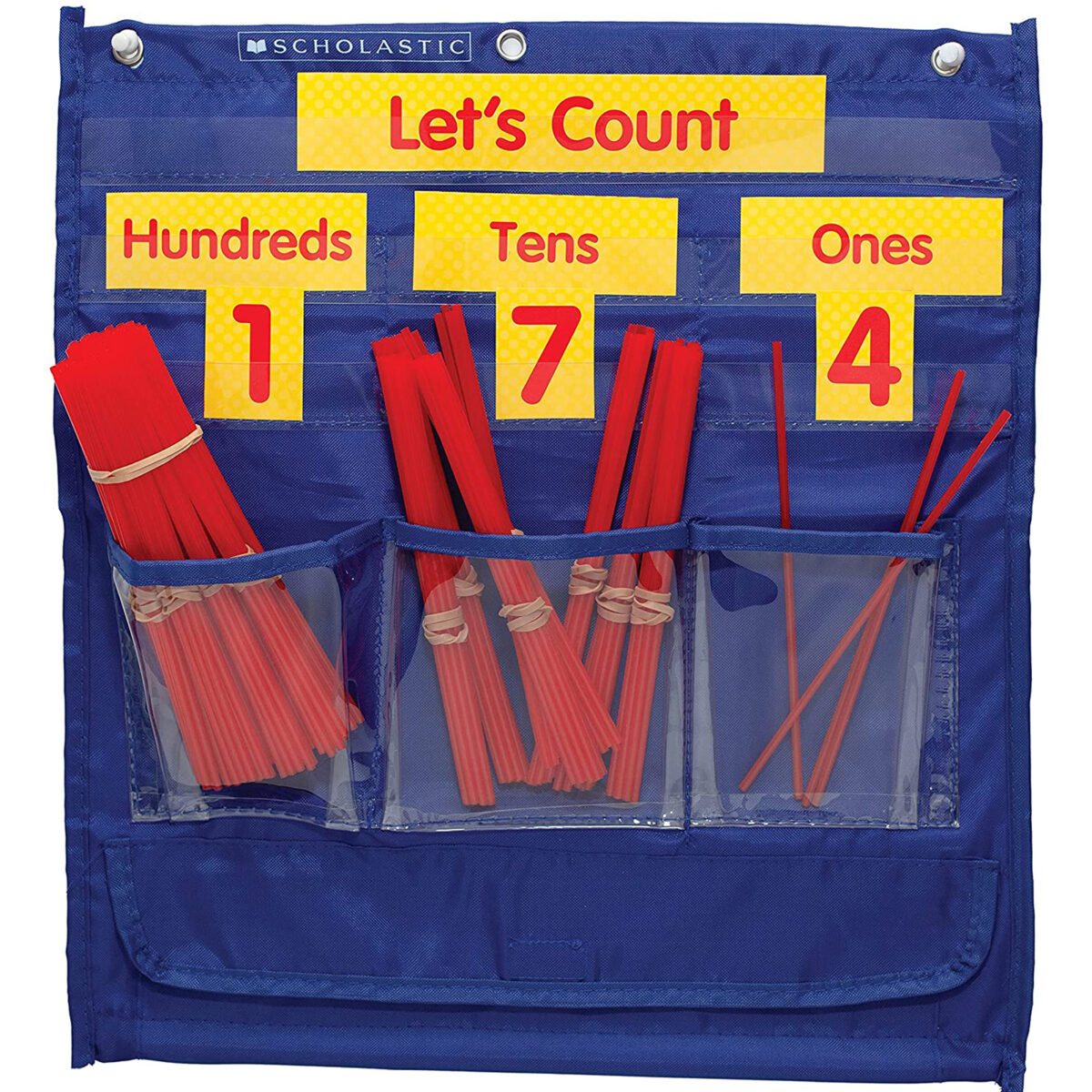
★★★★★
For School | Age 3-5 | 2-4 Students
Counting Caddie and Place Value Pocket Chart is another classroom teaching tool for teaching place values with 3 digits.
is another classroom teaching tool for teaching place values with 3 digits.
Just like Counting Straws Pocket Chart from Carson Dellosa Publishing, it includes
- 30 number cards (3 pieces for each number from 0-9)
- 3 place value cards (used as labels for ones, tens, hundreds)
- 200 plastic counting straws
Overall, I like this chart because:
- It is more durable (made of nylon)
- The number cards are larger (more visible from afar)
- It has a storage pocket on the chart for the straws
- The contrast of the straws and the pocket is better (better visual appraisal of the number of straws)
Place Value Activity Sets
In this section, I list place value activity sets that are played with a variety of manipulatives. The activities include stacking bricks, writing numbers, and solving place value problems.
Place Value Activity Kit (Lakeshore Learning)

★★★★☆
For School | Age 6-8 | 1-2 Students
In Place Value Activity Kit , players build the number using colorful rods, flats and cubes on activity mats according to ones, tens, hundreds and thousands. Then, they write the corresponding number at the bottom of the mat.
, players build the number using colorful rods, flats and cubes on activity mats according to ones, tens, hundreds and thousands. Then, they write the corresponding number at the bottom of the mat.
Children will enjoy building numbers because they can play with
- 100-unit cubes
- ten 10-unit rods
- ten 100-unit flats
- one 1,000-unit cube
This kit is best used alone or with a partner because there are only 2 erasable mats and 2 write and wipe markers.
Although this activity set has no self-checking mechanism, I still recommend this to 6–8-year-old children because building blocks boost understanding of place values. Children can see the connection between the number and its value because the kit’s pieces and the numbers are done on the same activity mat.
In brief, this is a great learning tool to understand place values with 4 digits.
Building Bricks Place Value Problem Solving Kit (Lakeshore Learning)

★★★★★
For School | Age 5-8 | 2-4 Students
Building Bricks Place Value Problem Solving Kit helps children learn place values by stacking lego-like bricks on building bases and by writing the correct digit on the erasable activity cards.
helps children learn place values by stacking lego-like bricks on building bases and by writing the correct digit on the erasable activity cards.
This activity set can be used by 4 students at once. There are 4 building bases where they can stack a total of 160 bricks.
Children will not get bored because they can try different activities. (There are 20 activity cards.)
The activity cards are divided into five categories:
- Building numbers
- Comparing numbers
- Adding with place value
- Subtracting with Place value
- Addition Word Problems
I really love these bricks because:
- Stacking lego type bricks is something children love to do
- 5×2 bricks (tens) are a brillant idea as they also help unerstand that 10=2×5
- The bricks use two colors (green and purple) which make the place value concept clear and easy to remember.
- Children can study place values without supervision because the answers are at the back of the card.
I just regret that there are not 10×10 flat boards (rather than only 20×20 yellow boards). 10×10 boards would have been ideal for figuring hundreds.
To use the set, children select a card to solve, stack bricks on a building base according to the place value and write the answers on the card.
I recommend this kit to 5–8-year-old children because it offers a concrete and exciting experience.
Place Value Activity Station (Lakeshore Learning)

★★★★☆
For School | Age: 7-9 | 2-4 Students
Place Value Activity Station is like a team-building game that has four activities designed to be played by 4 students at the same time. Each activity has a specific set of materials which include an activity guide and an answer key.
is like a team-building game that has four activities designed to be played by 4 students at the same time. Each activity has a specific set of materials which include an activity guide and an answer key.
- The first activity requires the student to arrange the tiles according to the number built on four spinners.
- The second activity directs the student to build the number using numbered tiles according to the base blocks on the flip chart.
- The third activity instructs the student to order and compare numbers (there are 3 sets for this part)
- The fourth activity requires the student to complete the activity mat with three cards that match the number on the left (cards contain word form, expanded form and base 10 blocks)
This set is great for individual and cooperative play in the classroom because:
- The materials are well-thought and of good quality.
- Students will have fun because they can try different sets in various occasions.
- Teachers can track the students’ progress using the assessment copy.
I recommend this activity set with 7–9-year-old children because they can switch from one instruction to another. They will learn place value by building and matching numbers in varied visual representations.
Whole Number Place Value Cards (Lakeshore Learning)

★★★☆☆
For School | Age 7-9 | 2-4 Students
Whole Number Place Value Cards consists of 200 color-coded cards that can be used as flashcards for place values or as activity cards for number expansion, addition, and subtraction.
consists of 200 color-coded cards that can be used as flashcards for place values or as activity cards for number expansion, addition, and subtraction.
The things I like about this activity set are:
- Flexibility (children can create small and large numbers by putting cards together while teachers can introduce addition and subtraction by manipulating the numbered cards)
- Easy to remember (colored cards help children identify place values quickly especially when they are adding or subtracting numbers, they can see the same color by columns)
Although the cards are thin and small, they are easy to manipulate.
There is an activity guide.
Visualize it! Part-Whole Place Value Cards (Lakeshore Learning)

★★★☆☆
For School | Age 6-8 | 2-4 Students
Visualize it! Part-Whole Place Value Cards focuses on teaching place values with 2-3 digits by solving the place value problem on the card.
focuses on teaching place values with 2-3 digits by solving the place value problem on the card.
This set has 100 double-sided cards that are labeled as 2-digit place and 3-digit place value problems.
Each card contains two bars. The top bar presents a number. The bottom bar breaks down the number in expanded form. Children must identify the number and place value represented by the question mark in the bottom bar. (The question mark changes its place)
The answers are written at the back so children can check their answers.
I recommend it because the cards are colorful, of good quality, and easy to understand.
Hands-On Math Teaching Kits (Lakeshore Learning)
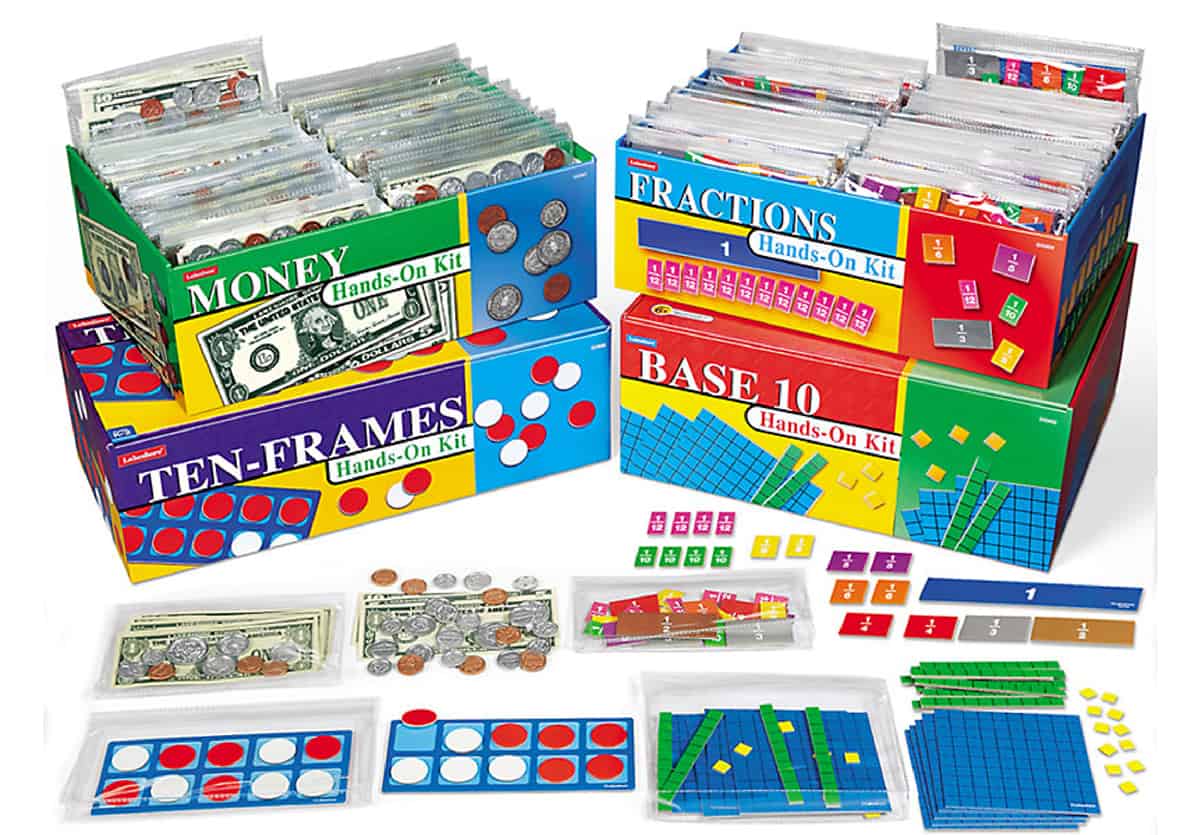
★★★☆☆
For School | Age 5-9 | 2-4 Students
Hands-On Math Teaching Kits include materials good for studying place values, fractions, and money.
include materials good for studying place values, fractions, and money.
Each kit contains 20 packs of math manipulatives and reproducible mats. For place value practice, children will enjoy the set for base ten and ten frames with colorful counters.
The base ten set includes chipboard base 10 pieces that represent hundreds, tens, and ones in each vinyl pouch. 6–8-year-old children can practice building the number, regrouping, and comparing values through expanded notation.
On the other hand, the ten frames have red and blue counters which are perfect for counting, addition, and subtraction.
The sets are durable and easy to use. It comes with an activity guide that would make this set helpful in a lot of math lessons from kindergarten to Grade 3.
Math Manipulative Toolbox (Lakeshore Learning)

★★★☆☆
For Home and School | Age 5-7 | 2-4 Students
Math Manipulative Toolbox contains activities for counting, comparing numbers, and studying base ten.
contains activities for counting, comparing numbers, and studying base ten.
This is an essential introductory kit for place values because it contains
- Erasable 120- chart (good for counting)
- 13 pattern blocks
- Base 10 blocks (10 green rods for tens and 25 yellow cubes for ones)
- 2 ten frames
- 20 colorful double-sided counters
- Activity guide
Children will enjoy the variety of activities they can do in one set. They can start developing their number sense using 120 charts and ten frames then follow it up with base ten activities.
Math Strategies School to Home Activity Kit (Lakeshore Learning)
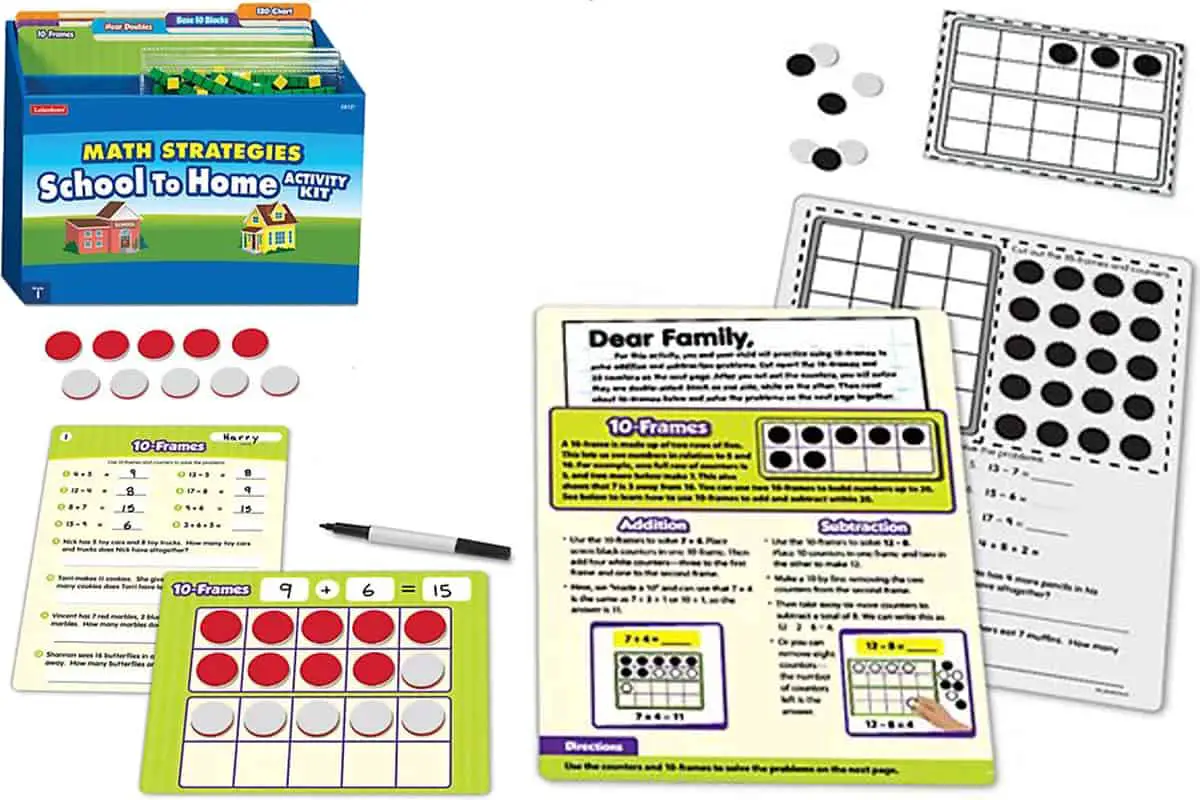
★★★★☆
For School & Home | Age 7-8 | 2-4 Students
Math Strategies School to Home Activity Kit enables children to practice place value concepts, addition and subtraction through two sets of activities, one for school and one for home practice.
enables children to practice place value concepts, addition and subtraction through two sets of activities, one for school and one for home practice.
This set is composed of base 10 blocks in a pouch and 4 activity cards for each category (a total of 16 reproducible activities)
- Ten frames
- Base 10
- Near Doubles
- 120 chart
Teacher lesson cards contain activities that explore
- ten frames using expanded notation and counters (10 frame mats and 25 counters)
- Base ten blocks (20 yellow units for ones, 20 green rods for tens and 10 blue blocks for hundreds)
- Near doubles chart
- 120 chart
Hands-on Math Manipulative Bundle (Lakeshore Learning)
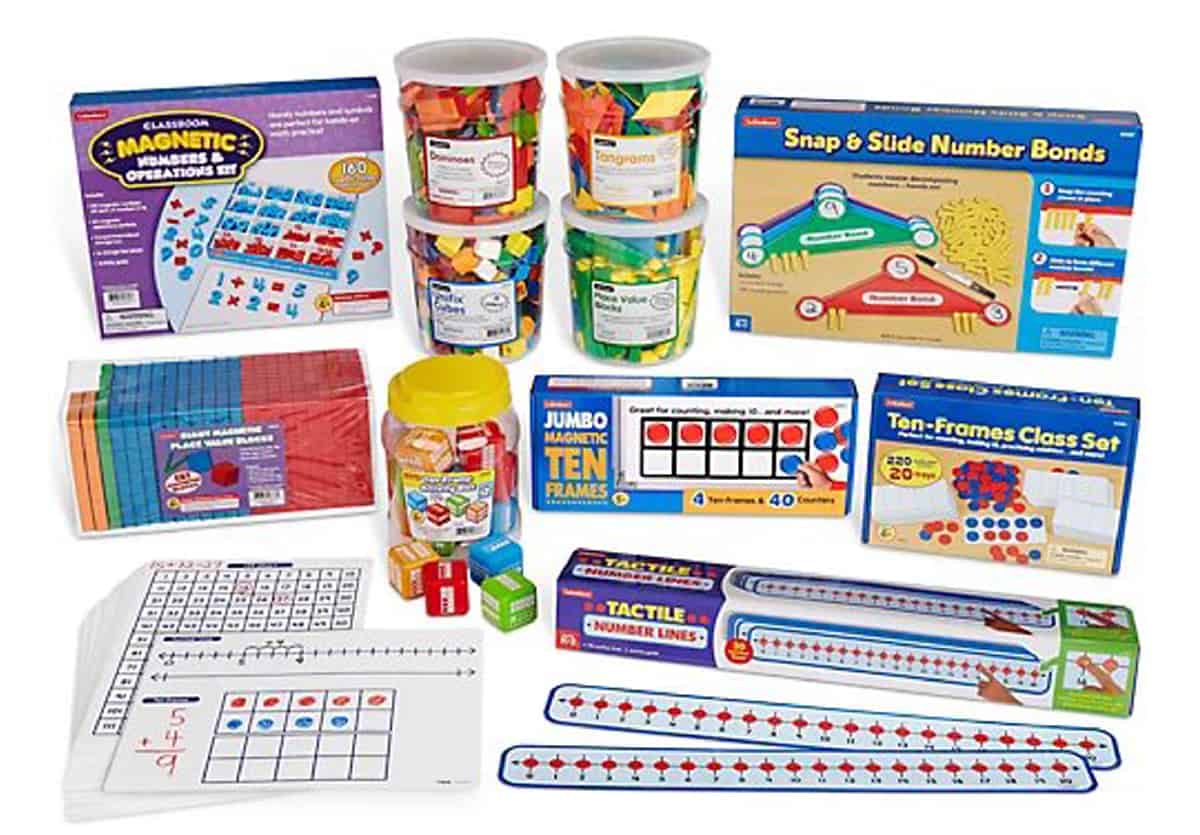
★★★☆☆
For School | Age 5-8 | 2-10 Students
So far, Hands-on Math Manipulative Bundle has the best set of manipulatives good for understanding place values with 3 digits.
has the best set of manipulatives good for understanding place values with 3 digits.
It contains 12 kits which include
- Ten frames class set (20 trays and 220 double-sided counters)
- Large magnetic ten frames (4 ten frames and 40 counters)
- Ten Frame Activity Dice (12 colorful die)
- Magnetic Place Value Blocks (121 pieces of color-coded blocks for ones, tens and hundreds)
- Write and wipe activity cards (number lines, ten frames, 120 chart)
- Number and Operations Kit (100 magnetic numbers and 60 operational symbols)
- Dominoes
- Tangrams
- Unifix cubes
- Place Value Blocks
- Snap & Slide Number Bonds
- Number Lines
I like this set because it offers multiple tactile activities to learn place values using
- Ten frames
- Place value blocks
- Unifix cubes
Additionally, children will learn basic arithmetic operations such as addition and subtraction. Teachers can plan the introduction of manipulatives with progression.
Other Place Value Manipulatives
The Small Wooden Number Cards (Elite Montessori)
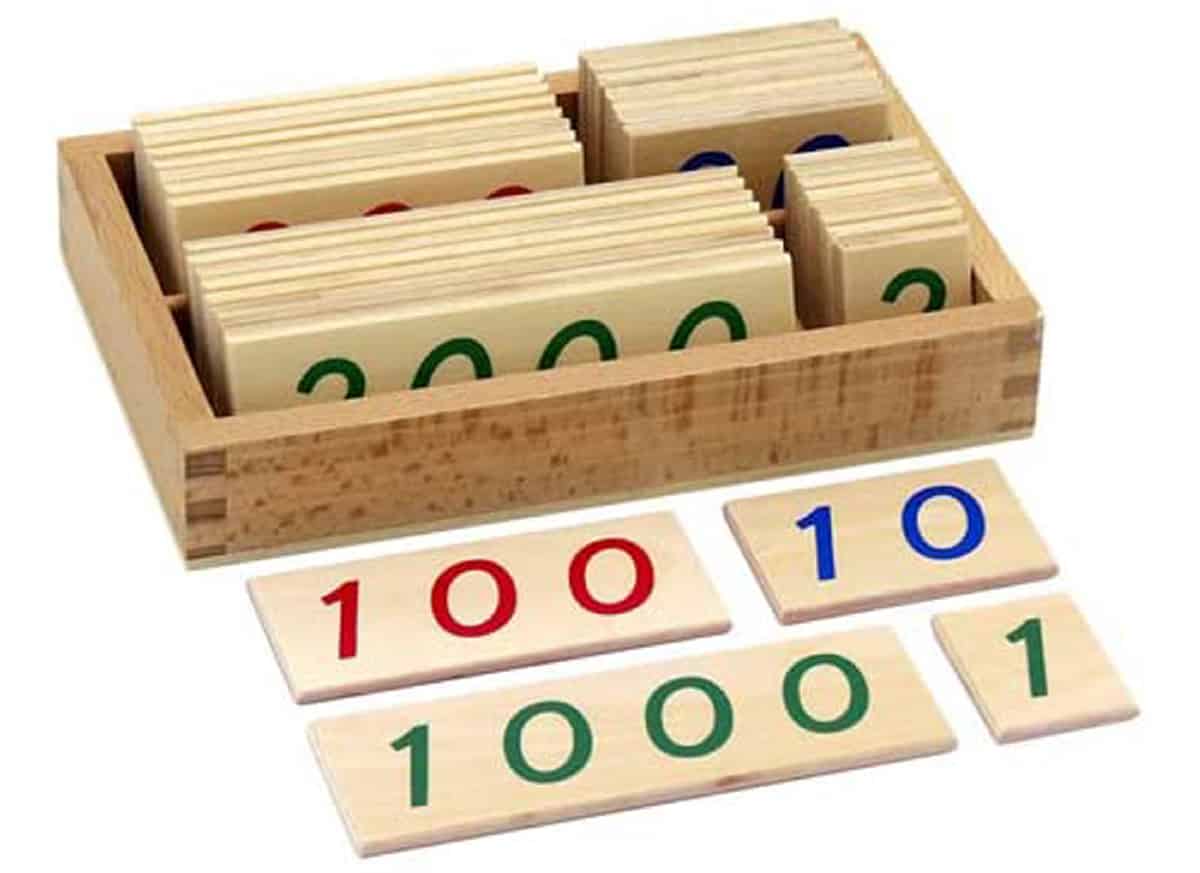
★★★☆☆
For School | Age 5-8 | 2-4 Students
The Small Wooden Number Cards enables children to practice place values through expanded notation.
enables children to practice place values through expanded notation.
The wooden box set contains tiles with color-coded numbers.
- 1-9 (green)
- 10-90 (blue)
- 100-900- (red)
- 1,000-9000 (green)
I like the feel of the tiles. It is made of pressed wood, smooth on the front and back but the edges were not finished. The material is sturdy, and the numbers are printed neatly – in the pure spirit of Montessori material.
Other Types of Place Value Games
Aside from place value activity sets, I have also made lists of place value games that you might want to check:
- 11 Place Value Card Games and Flashcards for Schools and Families

- 12 Place Value Board Games for Schools and Families

- 11 Place Value Dice Sets for Schools and Families
- 6 Place Value Puzzles for Children from Kindergarten to Grade 2
Edudingo.com is a participant in the Amazon Services LLC Associates Program, an affiliate advertising program designed to provide a means for sites to earn advertising fees by advertising and linking to Amazon.com. We also participate in other affiliate programs which compensate us for referring traffic.

